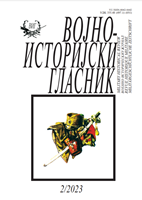ЈАЧИНА И КВАЛИТЕТ ЊЕМАЧКИХ ТРУПА У ЈУГОСЛАВИЈИ 1943–1945.
STRENGTH AND QUALITY OF GERMAN TROOPS IN YUGOSLAVIA 1943-1945
Author(s): Gaj TrifkovićSubject(s): Military history, WW II and following years (1940 - 1949), Fascism, Nazism and WW II
Published by: Institut za strategijska istraživanja
Keywords: World War Two; Yugoslavia; Wehrmacht; Strength; Guerrilla Warfare; Counterinsurgency;
Summary/Abstract: Allegations about the number of German soldiers engaged in Yugoslavia was one of the pillars of the narrative about the “People’s Liberation War”. This issue, however, was never given a proper historiographical treatment in the socialist period. It would have shown that the number of units in Yugoslavia depended on external factors (events on major fronts and broader strategic deliberations) at least to the same extent as on internal ones (guerrilla danger), that the occupation contingent was of highly heterogeneous nature, and that large numbers are not always synonymous for combat quality. This research, based almost entirely on unpublished primary sources, will attempt to provide a comprehensive account of the strength and quality of the German occupation contingent in the second half of the war. The original plan to hold the country with a symbolic force of 2 to 4 divisions was shattered already in the summer of the same year by the outbreak of the uprising in occupied Serbia and the NDH. From the early 1942 to mid-1943, anywhere from 4 to 7 divisions were engaged in anti-guerrilla duties, and from the summer of 1943 until the arrival of the Red Army in the late autumn of 1944, from 5 to 9 divisions (parts of the divisions that were nominally responsible for securing the coast, yet in practice constantly engaged against the Partisans, not counted). In the final phase of the war, almost the entire German contingent consisting of 11 to 15 divisions (including those stationed in Slovenia) ended up fighting the regular Yugoslav army. Apart from the divisions, dozens of independent combat battalions were involved in these operations. In the worst case, a large percentage of all these units could have been used to secure the rear areas of the main fronts, and a smaller percentage could be used directly against the Allied armies. Although, in general, these formations were of lower combat value, there is no doubt that their deployment to a secondary theater of war such as the Yugoslav one was to the detriment of the German war effort.
Journal: Vojnoistorijski glasnik
- Issue Year: 2023
- Issue No: 2
- Page Range: 131-161
- Page Count: 31
- Language: Bosnian

